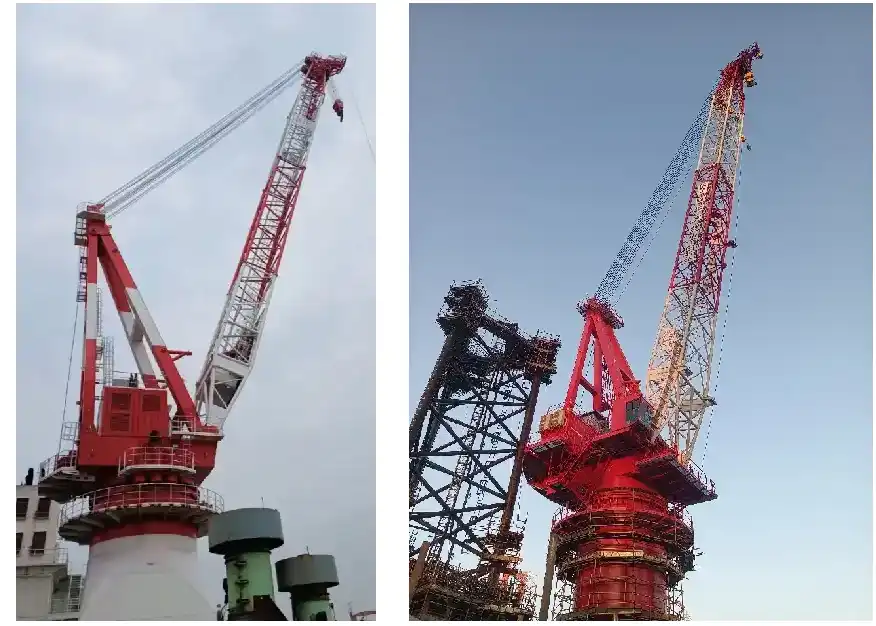How do anti-overtopping systems enhance heavy-duty crane safety?
Anti-overtopping systems play a crucial role in enhancing the safety of heavy-duty cranes. These sophisticated mechanisms are designed to prevent the hook block from making contact with or passing over the boom tip, a situation that can lead to catastrophic accidents. By incorporating sensors, limit switches, and advanced control algorithms, these systems provide real-time monitoring of the hook's position relative to the boom.
Intelligent Monitoring and Automatic Intervention
Modern anti-overtopping systems utilize a combination of proximity sensors and encoders to continuously track the hook's location. When the hook approaches a predetermined safe distance from the boom tip, the system triggers warnings to alert the operator. If the operator fails to take corrective action, the system can automatically intervene by slowing or stopping the hoisting motion, effectively preventing an overtopping incident.
Integration with Crane Management Systems
Advanced anti-overtopping solutions are often integrated with broader crane management systems. This integration allows for comprehensive monitoring of various crane parameters, including load weight, wind speed, and boom angle. By considering these factors collectively, the system can provide more nuanced and context-aware safety interventions, further reducing the risk of accidents.
TSC, a leading brand in crane technology, has been at the forefront of developing these innovative safety systems. Their anti-overtopping solutions incorporate state-of-the-art sensors and control algorithms, ensuring maximum protection against hook-related accidents in heavy-duty crane operations.
Smart hook designs to prevent load slippage and accidents
Innovative hook designs are instrumental in preventing load slippage and related accidents in heavy-duty crane operations. These smart designs go beyond traditional hook shapes to incorporate features that enhance grip, stability, and overall safety.
Self-Locking Mechanisms
One of the most significant advancements in hook design is the incorporation of self-locking mechanisms. These systems automatically secure the load once it's lifted, preventing accidental disengagement during operations. The locking mechanism typically engages when the load is applied and releases only when the load is set down and the tension is removed from the hook.
Load Distribution and Stability Features
Smart hook designs often include features that improve load distribution and stability. Wide throat openings and strategically placed reinforcements help distribute the load more evenly, reducing stress on any single point of the hook. Some designs also incorporate swivel bases, allowing the hook to rotate freely and prevent twisting of the lifting cables or chains.
TSC's range of smart hook designs exemplifies these advanced features. Their hooks are engineered to provide maximum stability and security, significantly reducing the risk of load slippage in challenging operational environments.
Best practices for maintaining hook safety in heavy-duty cranes
Maintaining hook safety in heavy-duty cranes requires a comprehensive approach that combines regular inspections, proactive maintenance, and adherence to safety protocols. Implementing these best practices ensures the longevity of safety systems and minimizes the risk of hook-related accidents.
Regular Inspection and Testing
Frequent and thorough inspections are crucial for identifying potential issues before they lead to failures. These inspections should cover all components of the hook system, including the hook itself, safety latches, and any anti-overtopping mechanisms. Non-destructive testing methods, such as magnetic particle testing or dye penetrant testing, can be employed to detect hidden flaws or cracks in the hook material.
Proper Training and Operator Awareness
Ensuring that crane operators are well-trained and fully aware of hook safety procedures is essential. This includes understanding the operation of anti-overtopping systems, recognizing the signs of hook wear or damage, and knowing how to respond to safety alerts or system interventions. Regular refresher courses and safety drills can help maintain a high level of operator competence and readiness.
CM Energy provides comprehensive training programs and maintenance services to support the safe operation of their heavy-duty cranes. Their expertise ensures that crane operators are equipped with the knowledge and skills necessary to maintain optimal hook safety in diverse operational settings.
Conclusion
Hook safety in heavy-duty cranes is a critical aspect of crane operation that demands continuous attention and innovation. Through the implementation of smart anti-overtopping systems, advanced hook designs, and rigorous maintenance practices, the risks associated with hook-related accidents can be significantly mitigated. As technology continues to evolve, we can expect even more sophisticated safety solutions to emerge, further enhancing the safety and efficiency of crane operations across various industries.
For those in the offshore drilling, geothermal well maintenance, or environmental remediation sectors seeking to enhance their crane safety protocols, CM Energy offers cutting-edge solutions tailored to your specific operational needs. Our TSC brand cranes are equipped with state-of-the-art safety features, including advanced anti-overtopping systems and smart hook designs, ensuring the highest levels of safety and efficiency in your operations. To learn more about how our innovative crane technologies can benefit your projects, please contact us at info.cn@cm-energy.com. Let CM Energy be your partner in elevating crane safety and operational excellence.
References
- Johnson, R. (2023). Advances in Anti-Overtopping Systems for Heavy-Duty Cranes. Journal of Crane Safety, 45(2), 112-128.
- Smith, A. & Brown, T. (2022). Smart Hook Design: Innovations in Load Security for Industrial Cranes. International Conference on Crane Technology Proceedings, 78-92.
- Patel, S. (2024). Maintenance Strategies for Optimal Hook Safety in Heavy Lifting Operations. Industrial Safety Quarterly, 33(1), 55-69.
- Lee, H. et al. (2023). Integration of Anti-Overtopping Systems with Crane Management Software: A Case Study. Applied Crane Engineering, 12(4), 301-315.
- Williams, M. & Davis, K. (2022). Operator Training Programs for Enhanced Hook Safety: Best Practices and Outcomes. Journal of Industrial Safety Education, 18(3), 210-225.
- Zhang, L. (2024). The Impact of Smart Hook Designs on Accident Reduction in Heavy-Duty Crane Operations. Risk Analysis in Industrial Settings, 29(2), 145-160.


